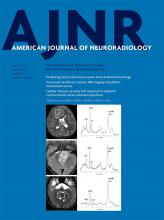Abstract
BACKGROUND AND PURPOSE: Focal cortical dysplasia (FCD) is one of the most common causes of drug resistant epilepsy. Our aim was to evaluate the role of presurgical noninvasive multimodality imaging techniques in selecting patients with refractory epilepsy and focal cortical dysplasia for epilepsy surgery and the influence of the imaging modalities on long-term seizure freedom.
MATERIALS AND METHODS: We performed a retrospective analysis of data of 188 consecutive patients with FCD and refractory epilepsy with at least 2 years of postsurgery follow-up. Predictors of seizure freedom and the sensitivity of neuroimaging modalities were analyzed.
RESULTS: MR imaging showed clear-cut FCD in 136 (72.3%) patients. Interictal FDG-PET showed focal hypo-/hypermetabolism in 144 (76.6%); in 110 patients in whom ictal SPECT was performed, focal hyperperfusion was noted in 77 (70.3%). Focal resection was the most common surgery performed in 112 (59.6%). Histopathology revealed FCD type I in 102 (54.3%) patients. At last follow-up, 124 (66.0%) were seizure-free. Complete resection of FCD and type II FCD were predictors of seizure freedom. Localization of FCD on either MR imaging or PET or ictal SPECT had the highest sensitivity for seizure freedom at 97.5%. Among individual modalities, FDG-PET had the highest sensitivity (78.2%), followed by MR imaging (75.8%) and ictal SPECT (71.8%). The sensitivity of MR imaging to localize type I FCD (60.8%) was significantly lower than that for type II FCD (84.8%, P < .001). Among 37 patients with subtle MR imaging findings and a focal FDG-PET pattern, 30 patients had type I FCD.
CONCLUSIONS: During presurgical multimodality evaluation, localization of the extent of the epileptogenic zone in at least 2 imaging modalities helps achieve seizure freedom in about two-thirds of patients with refractory epilepsy due to FCD. FDG-PET is the most sensitive imaging modality for seizure freedom, especially in patients with type I FCD.
ABBREVIATIONS:
- EEG
- electroencephalography
- FCD
- focal cortical dysplasia
- ILAE
- International League Against Epilepsy
- © 2019 by American Journal of Neuroradiology












